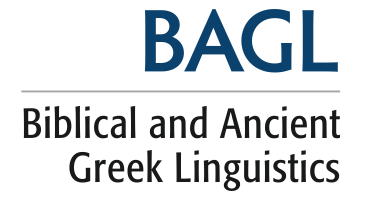2.1 | Paul L. Danove Villanova University, Villanova, PA, USA This article develops five features that describe the conceptualizations of
the event of transference grammaticalized by New Testament verbs, and uses these
features to formulate a model of the possible New Testament usages of transference.
The discussion resolves all New Testament occurrences of verbs that designate
transference into one of eighteen usages with distinct feature descriptions, and
considers the usages of transference predicted by the feature model but not realized
in the New Testament. Keywords: feature, transference, semantic, syntactic, verbal usage |
2.2 | Jonathan M. Watt Geneva College, Beaver Falls, PA, USA Diminuted word forms in the Greek New Testament have much in common with their
counterparts in other languages, and typically convey smallness, slightness,
affection, or derogation. In some cases their meanings are “faded” or “bleached” and
do not convey anything different from the base form of the word, as happens also in
other languages. Diminutive usage can express solidarity and common values in
certain speech communities, and may be doing so in some New Testament
passages. Keywords: diminutives, affixation, sociolinguistics, theory of language |
2.3 | Stanley E. Porter McMaster Divinity College, Hamilton, ON, Canada The utility of the lexical semantic theory of monosemy is demonstrated.
Negative associations with θαυμάζω in Mark 6:6 and Luke 11:38 are due to
co-textual features and not inherent to the word itself. Keywords: monosemy, polysemy, θαυμάζω, Mark 6:6, Luke 11:38,
co-text |
2.4 | Gregory P. Fewster Hamilton, ON, Canada Where does text fit into a theory of social identity? Social groups
consistently emerge and maintain their existence in relation to (sacred) texts:
Christians with their Bible, Muslims with the Qu’ran, or socialists with Das
Kapital. This is neither new nor surprising in- formation. Critics are intensely
aware of how individuals and groups engage in ongoing processes of identification in
relation to the sacred text. In this article, I explore the relationship between
social context and text and the constructive potential between the two. What are
mechanisms that trigger and maintain social change vis-à-vis text and how can these
dynamics be productively analyzed? It has become popular to invoke certain
constructivist views of social dynamics and, in particular, to marshal the notion of
“identity” as a powerful means for social-boundary maintenance and change. In
relation to that pro- pensity, this article is meant as an assessment of
methodologies that may be equal to this task, touching on various theories of
language and the construction of social identity, followed by exploration of a
particularly promising avenue developing from theories of ecosocial semiotics. Keywords: semiotics, identity, text, relativity, context, ecosocial,
eucharist |
2.5 | Hughson Ong McMaster Divinity College, Hamilton, ON, Canada This article applies various sociolinguistic and multi- lingualism theories to
analyze the linguistic situation of the episodes of Jesus’ betrayal, arrest, and
trial in Matt 26:36–27:26. It demon- strates that the linguistic complexities of a
multilingual society, in which Jesus lived, must have warranted the use of language
varieties in various sociolinguistic contexts, in order for people from various
social groups to interact with and accommodate each other. Thus, against Loren
Stuckenbruck’s assertion, in a recent essay “‘Semitic Influence on Greek’: An
Authenticating Criterion in Jesus Research?” in Jesus, Criteria, and the Demise
of Authenticity, that “For historical Jesus research, linguistic analysis
does not and cannot stand on its own” (94), this article otherwise contends that an
episode, saying, or action of Jesus, independent of other criteria, may be deemed
authentic without resorting to detection of a Semitic Vorlage behind the Greek text
to signal “authentic material.” Keywords: Matt 26:36–27:26; sociolinguistics, multilingualism, historical Jesus,
criteria, authenticity, language |

